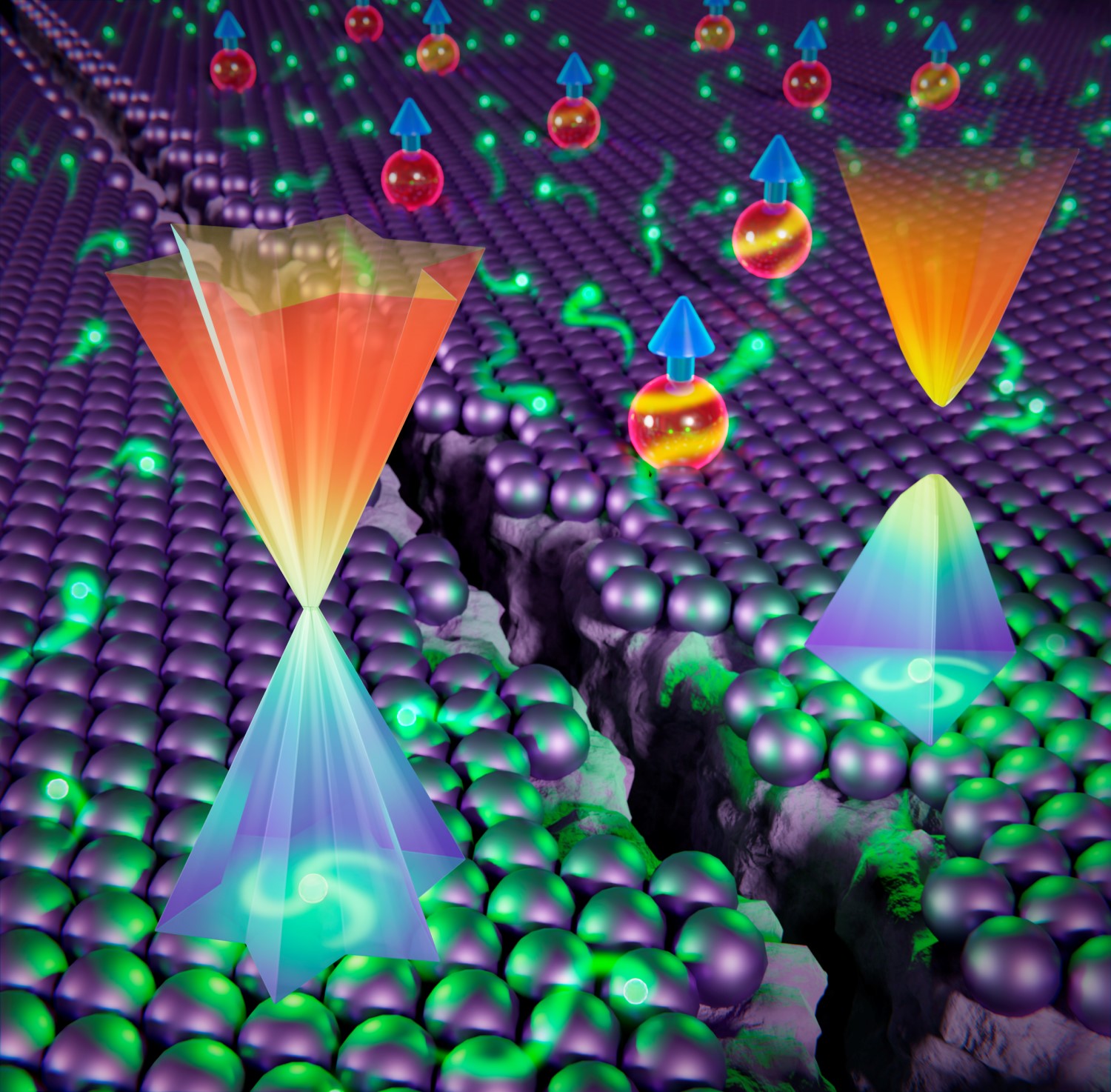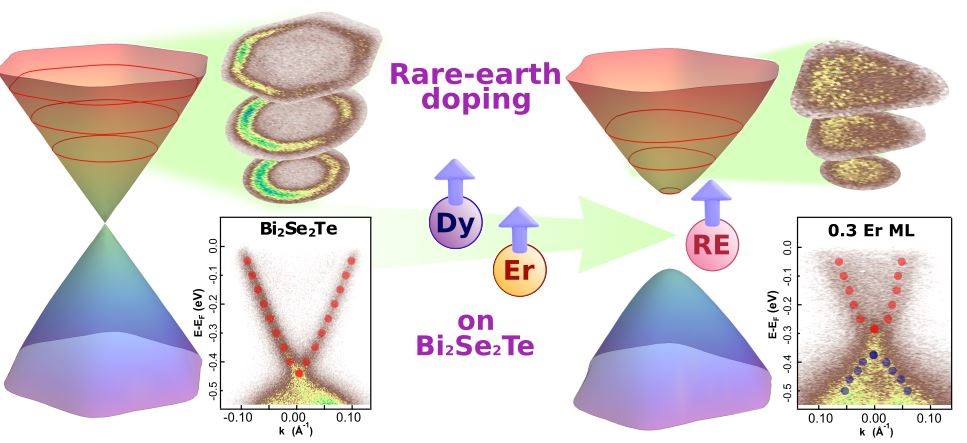A new spectroscopic fingerprint of magnetic interactions between topological states and Rare-Earth magnetic dopants, first paper of the Spin-ARPES lab at IMDEA Nanociencia
23.05.2023
 |
|
Bandgap opening and subsequent warping transition in Bi2Se2Te induced by rare-earth surface doping with Er and Dy magnetic impurities. Credit: Patricia Bondía. |
- Miguel Angel Valbuena's group uses angle-resolved photoemission spectroscopy (ARPES) to reveal, for the first time, a new spectroscopic signature of magnetic interactions between surface topological states and magnetic impurities.
- Experimental results, in collaboration with the First Principles Modelling for Quantum Materials group at the institute, have been rationalized according to a theoretical model that includes a magnetic term in the Hamiltonian governing the topological surface electrons.
- This groundbreaking research will make a significant contribution to our understanding of magnetic interactions with topological states, which are fundamental to highly relevant quantum phenomena such as the quantum anomalous Hall effect. This effect has been widely sought after and holds the key to making significant advancements in spintronic devices.
-
This research, conducted in collaboration with scientists from the ALBA Synchrotron, the Catalan Institute of Nanoscience and Nanotechnology, and the Bulgarian Academy of Science, is also the first scientific publication whose experimental data has been measured at the recently created LOREA beamline at the ALBA Synchrotron.
Madrid, May 23rd, 2023.
The discovery of topological insulators almost two decades ago has led to exciting new possibilities in materials science and technology. These unique materials behave as insulators in their interior but conduct electricity on their surfaces due to the topological order of their electronic states. This topological order is related to the intriguing property that the spin is locked to the momentum, meaning that for a given propagation direction of electrons, their spin orientation is uniquely defined and is topologically protected. Moreover, interfacing topological insulators with other magnetic or superconducting materials can lead to fascinating and exotic quantum phenomena, such as the quantum anomalous Hall effect or Majorana fermions, which have the potential to revolutionize spintronics technology and quantum computing. These materials have opened up a new frontier in materials science, offering exciting possibilities for future technology.
In particular, the quantum anomalous Hall effect is an intriguing phenomenon that can occur in topological insulators when their time-reversal symmetry is broken. Time-reversal symmetry is the property that protects the topological order of surface electrons from external disturbances, as scattering by impurities or defects at the surface. However, if magnetic impurities with a perpendicular magnetic moment interact with the material's surface electrons, this symmetry can be broken. This results in a gap opening at the Dirac point in the Dirac cone that describes the relativistic surface electrons in topological insulators (similar to other popular two-dimensional systems like graphene). In such a case, if this energy gap is tuned at the Fermi level (i.e., the energy of the conducting electrons) the realization of the quantum anomalous Hall effect could be achieved. This effect results in non-dissipative spin-polarized currents without the need for an external magnetic field.
Detecting the gap opening in topological insulators has been a long-standing challenge in understanding the interactions between magnetic systems and topological states. Their newest work, published in Nano Letters, has not only achieved this goal, but has also provided the first experimental evidence of a unique and unambiguous spectroscopic fingerprint, which confirms the breaking of time-reversal symmetry. The breakthrough lies in the observation of a change in the symmetry of the topological states, as shown in the images. Specifically, the conduction electrons, which were previously described by a hexagonally deformed, warped, Dirac cone, undergo a transformation to a trigonal symmetry due to interaction with out-of-plane magnetic moments. In our study, we used rare earth elements such as Erbium and Dysprosium as surface magnetic dopants on a prototypical three-dimensional topological insulator (Bi2Se2Te). Our initial hypothesis was that the large magnetic moment and anisotropy of magnetic rare-earth elements used as dopants could eventually maximize the gap opening.
In conclusion, this new finding sheds light on the complex interplay between magnetic systems and topological states and could pave the way for the realization of the quantum anomalous Hall effect under less extreme conditions than previously reported, leading to potential breakthroughs in the field of spintronics.

Dr. Miguel A. Valbuena, responsible for the Spin-ARPES laboratory at IMDEA Nanociencia, says that “Overall, this work is significant because it shows new experimental evidence at the origin of the realization of the quantum anomalous Hall effect. Our findings offer new ways to control magnetic interactions through surface states, which could be used to create new technologies, offering a promising path towards the creation of efficient and low-power electronic devices. This breakthrough could eliminate limiting factors that currently prevent the feasible industrial application of the quantum anomalous Hall based technologies. These limiting factors include the necessity of cooling down systems to very low, cryogenic, and non-practical temperatures or applying very large external magnetic fields that are difficult to scale. The most exciting thing about our results is that we have demonstrated a clear connection between magnetism and topology in a very simple and elegant way in these materials through the observation of the warping transition and the bandgap opening, which had been both predicted but not yet simultaneously observed in a experiment.”
This research result is a collaboration between researchers at IMDEA Nanociencia, ALBA synchrotron (LOREA beamline), the Catalan Institute of Nanoscience and Nanotechnology (ICN2) and the Bulgarian Academy of Science and have been cofunded by Spanish Ministry of Science and Innovation (MICINN) and the Spanish Research Agency through CONPHASETM project (PI: Miguel A. Valbuena), the Severo Ochoa Centre of Excellence award to IMDEA Nanociencia and by the European Regional Development Fund (ERDF) within the Framework of the Smart Growth Operative Programme 2014-2020 for the implemtation of LOREA beamline .
Reference:
B. Muñiz Cano et al. Experimental Demonstration of a Magnetically Induced Warping Transition in a Topological Insulator Mediated by Rare-Earth Surface Dopants. Nano Lett. 2023. DOI: 10.1021/acs.nanolett.3c00587
![]() https://repositorio.imdeananociencia.org/handle/20.500.12614/3339
https://repositorio.imdeananociencia.org/handle/20.500.12614/3339
Contact
Dr. Miguel Ángel Valbuena Martínez
miguelangel.valbuena[at]imdea.org
Telephone: 912998878.
ORCID: 0000-0002-0585-5636
Researchegate profile:: https://www.researchgate.net/profile/Miguel-Valbuena-2
Group webpage: https://www.nanociencia.imdea.org/es/spin-arpes/home
Communication and Dissemination Office at IMDEA Nanociencia
divulgacion.nanociencia [at]imdea.org
Twitter: @imdea_nano
Facebook: @imdeananociencia
Instagram: @imdeananociencia
Source: IMDEA Nanociencia




